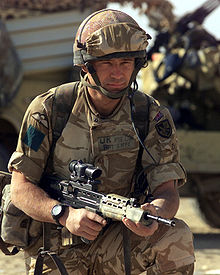
A bulletproof vest, also known as a ballistic vest or a bullet-resistant vest, is an item of body armour that helps absorb the impact and reduce or stop penetration to the torso by firearm-fired projectiles and fragmentation from explosions. The vest may come in a soft form, as worn by many police officers, prison officers, security guards, and some private citizens, used to protect against stabbing attacks or light projectiles, or hard form, using metallic or para-aramid components. Soldiers and police tactical units wear hard armour, either in conjunction with soft armour or alone, to protect against rifle ammunition or fragmentation.

Modular Lightweight Load-carrying Equipment, or MOLLE, is the current generation of load-bearing equipment and backpacks used by a number of NATO armed forces, especially the British Army and the United States Army.

Personnel Armor System for Ground Troops is a combat helmet and ballistic vest that was used by the United States military from the early 1980s until the mid-2000s, when the helmet and vest were succeeded by the Lightweight Helmet (LWH), Modular Integrated Communications Helmet (MICH), and Interceptor Body Armor (IBA) respectively.
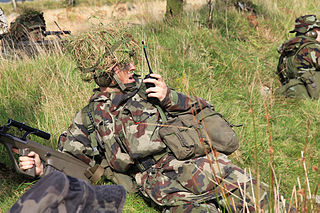
Personal Load Carrying Equipment (PLCE) is one of several tactical webbing systems of the British Armed Forces. Dependent upon the year of design, and the decade of introduction, the webbing system was named and is commonly referred to as the 85 Pattern, the 90 Pattern or the 95 Pattern webbing.

Disruptive Pattern Camouflage Uniform (DPCU), also nicknamed Auscam, jelly bean camo, or hearts and bunnies is a five-colour military camouflage pattern used by the Australian Defence Force. Replacing the jungle greens used from WWII, it was developed and tested during the late 1970s and early 1980s. The uniform was trialled in 1987, with it being slowly introduced in late 1989, with the last production and discontinuation of the jungle greens being in late 1990. Jungle greens were last issued in late 1991 for Australian Regular Army, and late 1994 for Australian Army Reserve.

The IIFS was introduced in 1988, to serve as a fighting and existence carrying system—a possible replacement for the All-purpose Lightweight Individual Carrying Equipment employed and fielded by United States Armed Forces since 1973.

The Modular Tactical Vest is a ballistic vest originally adopted by the United States Marine Corps in 2006. The MTV was designed as a solution to shortcomings in the Interceptor Body Armor (IBA) and was selected after a rigorous proposal and examination process by the Marine Corps. The MTV provides better protection levels than the IBA, although it uses the same Small Arms Protective Insert (SAPI) plates. The MTV weighs 30 pounds (14 kg), three pounds more than the IBA, but is designed to more effectively distribute its weight throughout the wearer's torso.

CIRAS is a modular protective vest designed for US Special Operations Forces by Eagle Industries. The vest is currently the new FSBE II system and has replaced the FSBE AAVs. It features PALS webbing, making it MOLLE-compatible and allowing the attachment of various pouches or accessories. Two versions of the vest are available, known as the "land" and "maritime" versions. The vest consists of front and rear panels with pockets for BALCS or SPEAR-cut soft armor panels and standard-issue SAPI plates. This gives the wearer up to NIJ Level IV protection on the front and back and Level IIIA protection on the sides. On the lower rear side of the front of the vest, there are two quick-releasable buckles for attaching groin protection. The wearer's sides are covered by an external cummerbund, which is also covered with PALS webbing. The vest body is constructed of 1000-denier Cordura Nylon, and the interior is lined with heavy-duty mesh to aid in cooling the wearer.
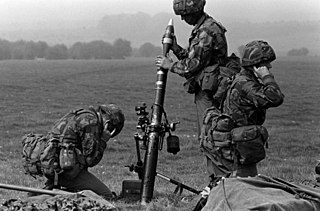
1958 Pattern Web Equipment was a modular personal equipment system issued to the British Armed Forces from 1959 up until the mid 90s. It replaced the 1937 Pattern Web Equipment that had served the UK's Armed Forces through the Second World War and the first decade of the Cold War and also the 1944 pattern Webbing which was used in jungle conditions starting from the mid-1960s.

The Improved Outer Tactical Vest (IOTV) is an enhanced version of, and a replacement for, the older Outer Tactical Vest (OTV) component of the Interceptor Multi-Threat Body Armor System, as fielded by the United States Army beginning in the mid-2000s. The IOTV is compatible with the Deltoid and Axillary Protector System (DAPS) components, ESAPI, Enhanced Side Ballistic Inserts (ESBI), as well as the OTV's groin protector. It has a flame-resistant standalone shirt, the Army Combat Shirt (ACS), designed specifically for use with the IOTV.

The Pouch Attachment Ladder System or PALS is a grid of webbing invented and patented by United States Army Natick Soldier Research, Development and Engineering Center used to attach smaller equipment onto load-bearing platforms, such as vests and backpacks. It was first used on MOLLE rucksacks, but is now found on a variety of tactical equipment, such as the U.S. Improved Outer Tactical Vest, Interceptor body armor, USMC Improved Load Bearing Equipment backpack and Modular Tactical Vest. It is used to attach items such as holsters, magazine pouches, radio pouches, knife sheathes, and other gear. A wide variety of pouches are commercially available, allowing soldiers to customize their kit. There is also a variety of attachment methods including the Alice Clip, the Natick snap, and soft, interwoven straps. The PALS system has begun to be adopted by other forces, such as the British Army, who use it on their Osprey body armor.

The Singapore Police Force has employed several different styles of uniforms throughout its history. Since 1969 it has used dark blue for its uniforms, although the first police uniforms introduced in 1856 were also in the same colour.
The Amphibious Assault Vest, Quick-Release, or FSBE AAV QR, is a light-weight assault vest system that incorporates both protection and cargo retention. Protection includes soft armor coupled with hard ballistic inserts. Cargo retention capabilities include various pouches and pockets attached via standard PALS webbing. The entire FSBE kit includes the vest body, a throat protector, a groin protector and an assortment of load bearing pouches. A fully loaded vest with armor plates can prove quite heavy, and is typically used only in high-risk direct action (DA) missions.

1937 Pattern Web Equipment was an item of military load-carrying equipment. It replaced the 1908 Pattern and 1925 Pattern—on which it was based—and was standard issue for British and Commonwealth troops from its introduction in 1937, throughout World War II, and in the post-war period until it was superseded by 1958 Pattern Web Equipment. It remained in limited use with Territorial Army and other second-line troops until the mid to late 1970s. Official use of the webbing in Community Cadet Forces and the Combined Cadet Force persisted into the 1980s.
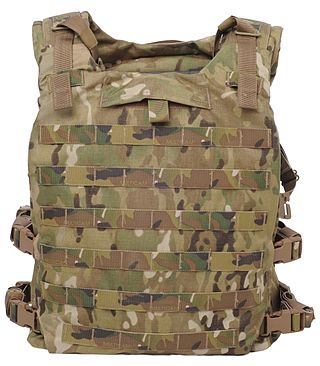
The Soldier Plate Carrier System (SPCS), known commercially as the KDH Magnum TAC-1, is a plate carrier developed for the U.S. Army which provides protection in accordance with if not greater than, the Improved Outer Tactical Vest. The SPCS is a lighter alternative to the IOTV, with increased mobility and comfort. The MSV, part of the US Army's SPS, is intended to replace all currently fielded body armor systems.

The Mark 7 helmet is a former general issue combat helmet of the British Armed Forces, which was replaced by the Revision Batlskin Cobra Plus as part of the Virtus programme. Officially known as the GS Mark 7 combat helmet, it replaced the previous Mark 6A helmet and Mk 6 helmet.
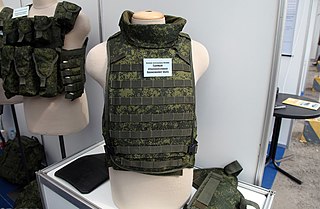
6B45 is a standard ballistic vest of the Armed Forces of the Russian Federation. It is a part of Ratnik infantry combat system. It was adopted in 2014 as a replacement for the 6B23 vest. 6B45 vest has been developed by Techinkom company located in Saint Petersburg.

6B5 "Ulej" is a bulletproof vest system created for the Soviet Armed Forces. Being an improvement in terms of protection over the previously issued 6B3 armor, 6B5 Ulej was in fact an entire system of ballistic vests for different branches of troops. It was created by NII Stali.

